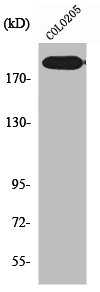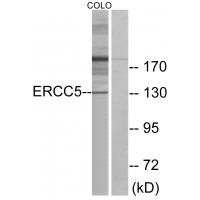XPG antibody
GTX20046
ApplicationsImmunoPrecipitation, Western Blot
Product group Antibodies
TargetERCC5
Overview
- SupplierGeneTex
- Product NameXPG antibody [8H7]
- Delivery Days Customer9
- Application Supplier NoteSuggested working dilutions: Western blot: 1:625-1:1250, immunoprecipitation: 2 microg/mg protein lysate.
- ApplicationsImmunoPrecipitation, Western Blot
- CertificationResearch Use Only
- ClonalityMonoclonal
- Concentration1 mg/ml
- ConjugateUnconjugated
- Gene ID2073
- Target nameERCC5
- Target descriptionERCC excision repair 5, endonuclease
- Target synonymsCOFS3, ERCC5-201, ERCM2, UVDR, XPG, XPGC, DNA excision repair protein ERCC-5, DNA repair protein complementing XP-G cells, XPG-complementing protein, excision repair cross-complementation group 5, excision repair cross-complementing rodent repair deficiency, complementation group 5, xeroderma pigmentosum, complementation group G
- HostMouse
- IsotypeIgG2a
- Protein IDP28715
- Protein NameDNA repair protein complementing XP-G cells
- Scientific DescriptionThis gene encodes a single-strand specific DNA endonuclease that makes the 3 incision in DNA excision repair following UV-induced damage. The protein may also function in other cellular processes, including RNA polymerase II transcription, and transcription-coupled DNA repair. Mutations in this gene cause xeroderma pigmentosum complementation group G (XP-G), which is also referred to as xeroderma pigmentosum VII (XP7), a skin disorder characterized by hypersensitivity to UV light and increased susceptibility for skin cancer development following UV exposure. Some patients also develop Cockayne syndrome, which is characterized by severe growth defects, cognitive disability, and cachexia. Read-through transcription exists between this gene and the neighboring upstream BIVM (basic, immunoglobulin-like variable motif containing) gene. [provided by RefSeq, Feb 2011]
- Storage Instruction-20°C or -80°C,2°C to 8°C
- UNSPSC12352203





